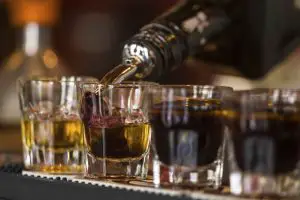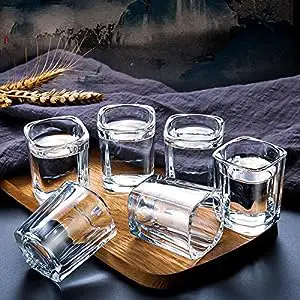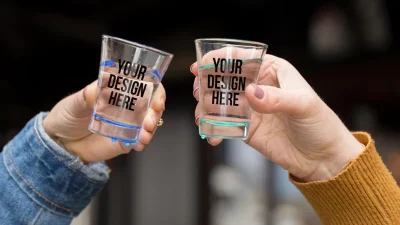When it comes to crafting the perfect cocktail or enjoying your favorite spirits, having precise measurements is crucial. But what do you do when you find yourself without the trusty shot glass that’s become synonymous with barware? Fear not, because in this guide, we’ll explore creative and practical ways on how to measure a shot without a shot glass.
Whether you’re at a friend’s house, camping in the wilderness, or simply don’t have access to the usual tools, these inventive methods will ensure you pour the perfect shot every time. So, let’s dive into the world of improvisation and learn how to measure your liquor like a pro, even when you don’t have the standard equipment at hand.
How can you measure a shot without a shot glass?

You can measure a shot without a shot glass by using various common household items or by employing some simple estimation techniques. Here are a few methods:
- Use a Standard Kitchen Spoon: A standard kitchen spoon, such as a tablespoon or a teaspoon, can be used to measure a shot. A standard shot is usually 1.5 ounces (44 milliliters), so you can use the following approximations:
-
- 1 tablespoon (15 milliliters) is roughly equivalent to 1/3 of a shot.
- 1 teaspoon (5 milliliters) is roughly equivalent to 1/15 of a shot.
- Use a Medicine Cup or Syringe: If you have a medicine cup or a syringe with measurements in milliliters, you can use it to measure the desired amount accurately. One shot is approximately 44 milliliters.
- Use a Common Glass: If you have a common glass or cup, you can estimate the shot size based on its capacity. Most shot glasses hold 1.5 ounces, so you can fill the glass to the appropriate level.
- Visual Estimation: If you don’t have any measuring tools available, you can estimate a shot visually. Pour the spirit slowly and steadily into your glass and stop when it reaches approximately the right amount. This method is less precise but can work if you’re not too concerned about an exact measurement.
- Counting Seconds: If you’re making a mixed drink and need a precise measurement, you can use the “counting seconds” method. A standard shot typically takes around 2 seconds to pour from a standard pour spout, yielding approximately 1.5 ounces. So, you can count how many seconds you pour to get your desired amount.
- Using a Bottle Cap: Some bottle caps have a consistent volume, often around 1 ounce. You can use the bottle cap as a makeshift measuring tool.
- Practice and Experience: With time and practice, you can develop an eye for measuring shots accurately by pouring them by hand. This method is not recommended for professional bartenders, but it can work for casual home use.
Remember that the accuracy of these methods may vary, so if precise measurements are crucial for your recipe, it’s best to invest in a set of measuring tools, including a shot glass or jigger, for consistent and reliable results.
What are alternative methods for measuring a shot?
Alternative methods for measuring a shot, aside from using standard measuring tools like a shot glass or jigger, include:
- Jigger or Measuring Cup: A jigger is a bartending tool designed specifically for measuring spirits accurately. It usually has two sides with different volumes, such as 1 ounce and 1.5 ounces, allowing you to measure shots precisely. Alternatively, a liquid measuring cup with ounce and milliliter markings can also serve this purpose.
- Count Pouring: Bartenders often use the “count pouring” method to measure shots without a jigger. This method relies on counting the seconds it takes to pour a specific amount of liquid. For example, a typical count pour might involve counting to 3 for a 1.5-ounce shot. This method requires practice to be accurate.
- Free Pouring with Practice: Experienced bartenders can free-pour shots without using any measuring tools. They’ve honed their pouring skills through practice and can accurately estimate the amount of liquid poured by sight. This method is not recommended for beginners.
- Using a Graduated Cylinder: If you have a graduated cylinder in your kitchen or bar, you can use it to measure shots accurately. Pour the spirit into the cylinder and read the volume markings to determine the shot size.
- Digital Kitchen Scale: While not common for measuring shots, a digital kitchen scale can be used to measure the weight of a shot accurately. You’ll need to know the density of the liquid you’re pouring and convert the weight measurement to volume based on that density.
- Eyeballing with Practice: With enough practice, you can become adept at estimating shot sizes by eye. This method is highly subjective and relies on your experience and familiarity with common shot volumes.
- Using Mini Liquor Bottles: Some liquor brands offer miniature bottles (often referred to as “mini bottles”) that contain a single shot’s worth of liquor. These can serve as pre-measured shots and are convenient for making cocktails.
- Mouth Pouring: This method is not recommended for beginners, but some experienced bartenders can accurately measure shots by pouring directly from the bottle into the glass while counting the duration of the pour. This technique requires a high level of skill and consistency.
Remember that the accuracy of these alternative methods may vary, and some may require more practice than others to achieve consistent results. For precise and reliable measurements, especially in a professional setting, using dedicated bartending tools like a jigger or shot glass is recommended.
What household items can be used to measure a shot?

Measuring a shot of liquid, typically for making cocktails, can be done using various household items if you don’t have a dedicated shot glass or jigger. Keep in mind that the standard shot size in most cocktail recipes is 1.5 ounces (44 milliliters), but some recipes may call for a different measurement. Here are some common household items you can use to measure a shot:
- Tablespoon: A standard tablespoon is approximately equivalent to half a fluid ounce, so you can use it to measure one shot (1.5 ounces) by using three tablespoons.
- Teaspoon: A teaspoon is approximately equivalent to 1/6th of a fluid ounce, so you can use it to measure a shot by using nine teaspoons.
- Egg Cup: Some egg cups are designed to hold a shot’s worth of liquid, making them a convenient option for measuring shots.
- Medicine Cup: The small cups that often come with over-the-counter liquid medications can be used to measure a shot.
- Shot Glass: While a dedicated shot glass is ideal, any small glass with markings for measuring ounces can be used.
- Measuring Cup: If you have a liquid measuring cup, you can use it to measure a shot by filling it to the 1.5-ounce mark.
- Kitchen Scale: If you have a kitchen scale, you can use it to measure the weight of the liquid. For a 1.5-ounce shot, it would be approximately 42.5 grams.
- Plastic Syringe: If you have a clean, unused plastic syringe with milliliter markings, you can use it to measure the appropriate amount.
- Eye Dropper: An eye dropper can be used for more precise measurements, particularly in small increments.
Remember to clean any of these items thoroughly before using them to measure a shot, especially if they’ve been used for other purposes. Additionally, be aware that the measurements may not be as accurate as using a dedicated shot glass or jigger, so use these household items as a last resort or for less precise recipes.
Can you use common kitchen utensils to measure a shot?
Yes, you can use common kitchen utensils to measure a shot if you don’t have dedicated bar tools like a shot glass or jigger. Keep in mind that the standard shot size in most cocktail recipes is 1.5 ounces (44 milliliters), but some recipes may call for a different measurement. Here are some common kitchen utensils you can use:
- Tablespoon: A standard tablespoon is approximately equivalent to half a fluid ounce. You can use it to measure one shot (1.5 ounces) by using three tablespoons.
- Teaspoon: A teaspoon is approximately equivalent to 1/6th of a fluid ounce. You can use it to measure a shot by using nine teaspoons.
- Measuring Cup: If you have a liquid measuring cup, you can use it to measure a shot by filling it to the 1.5-ounce mark.
- Kitchen Scale: If you have a kitchen scale, you can use it to measure the weight of the liquid. For a 1.5-ounce shot, it would be approximately 42.5 grams.
- Dinner Fork: Some dinner forks have a tine that’s roughly equivalent in size to one fluid ounce. You can use the fork to measure out one shot and a half (1.5 ounces) by filling the tine and leveling it off.
- Plastic Syringe: If you have a clean, unused plastic syringe with milliliter markings, you can use it to measure the appropriate amount.
- Eye Dropper: An eye dropper can be used for more precise measurements, especially for small increments.
While these kitchen utensils can be used to measure a shot, keep in mind that they may not be as accurate as dedicated bar tools like jiggers or shot glasses. For more precise cocktail making, it’s advisable to invest in proper barware.
Additionally, make sure to clean any utensils thoroughly before using them for measuring shots, especially if they’ve been used for other purposes.

How do you ensure the right shot size without a shot glass?
Ensuring the right shot size without a shot glass can be done with some creativity and improvisation. Here are a few methods you can try:
- Use Common Kitchen Items:
-
- Measuring Spoons: Many measuring spoons have markings for tablespoons and teaspoons. You can use these to approximate the right shot size. For example, a standard 1.5-ounce shot is approximately equal to 3 tablespoons or 9 teaspoons.
- Regular Glassware: You can use regular glassware, like a small juice glass or a rocks glass, to estimate the shot size. Familiarize yourself with the volume these glasses hold to pour approximately the right amount.
- Use a Standard Can or Bottle:
-
- The opening of a standard soda or beer can is approximately 12 ounces. You can use this as a reference point. For example, a 1.5-ounce shot is roughly 1/8th the volume of a standard can.
- A standard beer bottle is typically 12 ounces, and a wine bottle is 750ml (approximately 25 ounces). You can use these as references for larger measurements.
- Counting Pours:
-
- You can pour your liquor directly into the cocktail shaker or mixing glass and count the seconds to estimate the shot size. A typical count is around 1 second per 1/4 ounce. So, for a 1.5-ounce shot, you would pour for about 6 seconds.
- Visual Estimation:
-
- Over time, you can develop an eye for estimating shot sizes based on the level of liquid in the glass. For example, a standard 1.5-ounce shot typically fills a shot glass to its brim.
- Invest in Jigger Tools:
-
- If you frequently make cocktails, consider investing in a jigger, which is a specialized measuring tool for bartenders. It usually has two sides, with one measuring 1 ounce and the other measuring 1.5 ounces, making it easy to pour standard shots.
- Practice and Consistency:
-
- Regardless of the method you choose, practice is key to achieving consistency. By using the same reference point or method each time, you can get better at pouring the right shot size without a shot glass.
Remember that precision is essential in some cocktails, so having a shot glass or jigger is ideal. However, these improvisational methods can work well for most home bartending needs. Always drink responsibly and be aware of the alcohol content in your drinks.
Conclusion
With the information on this page, you can learn how to measure a shot without a shot glass. To measure a shot without a shot glass, you can use common kitchen items like measuring spoons or regular glassware, estimate pours based on counting seconds, or visually gauge the amount.
Consistency and practice are key to achieving accurate measurements, but for precision, investing in a jigger or shot glass is recommended. Always drink responsibly and be aware of alcohol content when improvising shot measurements.


